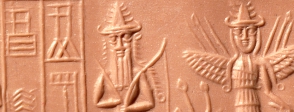Here is a range of activities that could be linked together or done separately. They begin with a focus on the seal itself and then move on to the gods more generally.
Show students the close-up of the greenstone seal impression in For the classroom. Explain that there are four gods in the picture. Read the class a description of each of the four gods and ask the students if they can work out which one you are describing. Ask students whether they can see any clues in the picture to what each god is responsible for; for example, how could they tell Ea is responsible for water?
Remind students that the gods on the seal all look a little different from each other. Show them the four other seal impressions in For the classroom. Ask the students to try to identify the gods and goddesses they have seen on Adda’s seal and pick out the clues they have used.
Remind the students that the ancient Mesopotamians worshipped many gods. Show them the overview of the Mesopotamian gods that you can find on the Mesopotamia website – see For the classroom. Explain that each god had a different purpose. Go through the table of gods and group them according to different aspects of life, geography and natural phenomena.
Using the table of gods on the website, pick out the gods on Adda’s cylinder seal and check the table with what the students thought about the gods. Ask students why they think the Mesopotamians had different gods and goddesses controlling different parts of life, such as the weather, a particular time of day, a place, or a job. Ask students why some gods were thought to be more powerful than others. What might make one god more powerful than another one?
Explain that ancient Mesopotamians told stories about their gods and goddesses to explain important aspects of the world. Go through the Babylonian Epic of Creation in the Story section of the Ancient Mesopotamia website – see For the classroom. Ask students if it is similar to any other stories they may know about creation. Ask them to make up a story based on what is happening on the cylinder seal.
Using the seal of Adda as an inspiration, ask students to draw their own cylinder seal design. Remind them that it has to tell a story. It could depict the creation story, or they could devise their own story based on one of the Mesopotamian gods. To make a cylinder seal, students could make a cylinder of self-drying clay, carve or impress a design, leave it to dry and then roll across clay or plasticine to make the impression. An alternative would be to carve a length of wax candle.
Ask students if they can name any other gods or goddesses they have heard of, either from their own culture, or from other cultures they have studied. You could use the images of gods in A bigger picture. Identify and discuss the similarities and differences across different cultures. You could then focus on one particular category of god, for example, the sun god or a god of growth.
Ask students about objects that carry images or symbols of gods. Where are these found – only in religious buildings or at home, carried on the person? What role do they play in the worship of the gods? Why do they think Adda had gods on his seal?


